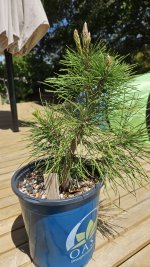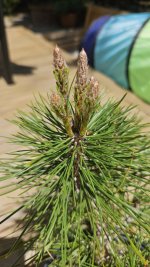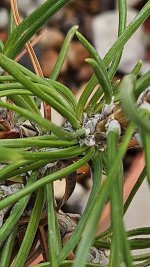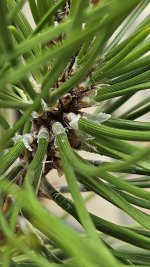Wulfskaar's Bristlecone Pine from seed
- Thread starter Wulfskaar
- Start date
Wulfskaar
Omono
MaciekA
Shohin
In your question above, do you mean to ask this about a bristlecone? I'm asking because the above picture is of not of a bristlecone. I grow bristlecone and it is very different-appearing from this since it is a 5-needle pine species. Perhaps this was the right tree, but the wrong title for the thread?
Wulfskaar
Omono
In your question above, do you mean to ask this about a bristlecone? I'm asking because the above picture is of not of a bristlecone. I grow bristlecone and it is very different-appearing from this since it is a 5-needle pine species. Perhaps this was the right tree, but the wrong title for the thread?
The seeds were labeled "Pinus aristata, Bristlecone pine".
It looks very much like pictures of seedlings I see online as well.
Another search shows "Pinus longaeva" and "Pinus aristata" both called "bristlecone pine".
MaciekA
Shohin
Do you have any close up pictures of the bases of needle bundles? The photos so far look like a 2-needle species. All bristlecone species are 5-needle pines. Arista, which I grow and am familiar with up-close, also has resin flecks/specks on the needles, but this one doesn't have those. The resin flecks are visible even on young seedlings like this one (look at the closeups): https://sequoiatrees.com/products/bristlecone-pine-pinus-aristata-large-tree-seedling
Colorado
Masterpiece
rusticana
Mame
Theres also rocky mountain bristlecone pine/ancient pine. But they are all 5 needle pines. I collected some of those seeds but was not successful like you. The needles are also a tad long compared to my mature specimen. With a white stripe. Though that could be environmental? Still good reason to be happy with your project.The seeds were labeled "Pinus aristata, Bristlecone pine".
It looks very much like pictures of seedlings I see online as well.
Another search shows "Pinus longaeva" and "Pinus aristata" both called "bristlecone pine".
Wulfskaar
Omono
Do you have any close up pictures of the bases of needle bundles? The photos so far look like a 2-needle species. All bristlecone species are 5-needle pines. Arista, which I grow and am familiar with up-close, also has resin flecks/specks on the needles, but this one doesn't have those. The resin flecks are visible even on young seedlings like this one (look at the closeups): https://sequoiatrees.com/products/bristlecone-pine-pinus-aristata-large-tree-seedling
I really appreciate the help on this!
Tomorrow I'll be able to get closer pics of this particular tree, as well as the others from the same batch from 2020. Some have the white flecks. I had always thought they were bird crap.
Here is a closeup of one of those others from the same seed pack. Some definitely have more than 2 needles from the same point. No white flecks on this one though. Some look like only 2.
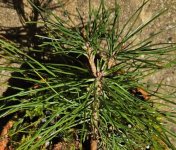
Wulfskaar
Omono
Wulfskaar
Omono
TacomaBonsai95
Mame
All the pictures look like they are either pinus thunbergii (japanese black pine) or pinus nigra (austrian black pine). Thunbergii that I have grown from seed usually have fairly straight needles.
Wulfskaar
Omono
Thanks! I really appreciate the input!All the pictures look like they are either pinus thunbergii (japanese black pine) or pinus nigra (austrian black pine). Thunbergii that I have grown from seed usually have fairly straight needles.
I have grown quite a few JBP, many at the same time as these, and they are definitely much different.
I will look into Austrian Black Pine.
Wulfskaar
Omono
I went and counted... of 8 that I thought were Bristlecones, only 3 are.
The other 5 are... Austrian Black Pine? I googled and they sure do look very, very close, @TacomaBonsai95 !!!
So, I guess this whole thread is effed up since the title is about Bristlecone!
Anyone else with Austrian Black Pine have opinions on that?
The other 5 are... Austrian Black Pine? I googled and they sure do look very, very close, @TacomaBonsai95 !!!
So, I guess this whole thread is effed up since the title is about Bristlecone!
Anyone else with Austrian Black Pine have opinions on that?
TacomaBonsai95
Mame
I've seen some nice bonsai specimen of Austrian black pine! Idk how they react to pruning though. Japanese black pine are a double flush Pine, while something like scots pine only produce one flush of growth consistently. You might need to treat it like scots pine when pruning. What you have could also be a japanese black pine though. It's worth getting some other opinions because I could be wrong!I went and counted... of 8 that I thought were Bristlecones, only 3 are.
The other 5 are... Austrian Black Pine? I googled and they sure do look very, very close, @TacomaBonsai95 !!!
So, I guess this whole thread is effed up since the title is about Bristlecone!
Anyone else with Austrian Black Pine have opinions on that?
Wulfskaar
Omono
I'm 99.9% sure they are not JBP. I have a bunch of those too, and they are different.I've seen some nice bonsai specimen of Austrian black pine! Idk how they react to pruning though. Japanese black pine are a double flush Pine, while something like scots pine only produce one flush of growth consistently. You might need to treat it like scots pine when pruning. What you have could also be a japanese black pine though. It's worth getting some other opinions because I could be wrong!
Wulfskaar
Omono
I just found that the same company "Nature's Blossom" also has a kit with Pinus nigra. I think it's easy to assume I got a mixed bag of seeds labeled "Pinus aristata".
The more I look into P. nigra, the more I think that's what these are!
TrimmyWhimmy
Yamadori
- Messages
- 55
- Reaction score
- 46
Make your thread about tree #3. Pretty sure that's a Bristlecone. 
Leo in N E Illinois
The Professor
- Messages
- 11,487
- Reaction score
- 23,830
- USDA Zone
- 5b
White flecks are not diagnostic, though are a tip off. Pretty much should have 5 needles per bundle, that is a tip off. Needles persists on branch upwards of 40 years, makes P. aristata quite different than JWP.
Pinus nigra - Austrian or European black pine is great for bonsai. Techniques are much like Pinus sylvestris, a single flush pine. You will enjoy working with them once you make the "mental shift".
Pinus nigra - Austrian or European black pine is great for bonsai. Techniques are much like Pinus sylvestris, a single flush pine. You will enjoy working with them once you make the "mental shift".
MaciekA
Shohin
I think that tree #3 could be a bristlecone -- the resin flecks are pretty hard to get from anything but the bristlecone group and it seems to have 5-needle bundles. There's not much else that fits that description. The tip buds will look very different, and also, once you get it really vigorous, you will have a LOT of random needle buds. A vigorous bristlecone will give you lots of useful needle buds. Needle length reduction will happen with ramification and as much sun as you can physically give it (once it's got good bushy roots at least).
(note: edited, I initially wrote "#4" here, definitely #3)
(note: edited, I initially wrote "#4" here, definitely #3)
Wulfskaar
Omono
I also noticed the 3 trees with 5 needles have shorter needles as well. The 5 with 2 needles have much longer needles.I think that tree #3 could be a bristlecone -- the resin flecks are pretty hard to get from anything but the bristlecone group and it seems to have 5-needle bundles. There's not much else that fits that description. The tip buds will look very different, and also, once you get it really vigorous, you will have a LOT of random needle buds. A vigorous bristlecone will give you lots of useful needle buds. Needle length reduction will happen with ramification and as much sun as you can physically give it (once it's got good bushy roots at least).
(note: edited, I initially wrote "#4" here, definitely #3)
Thank you so much for your insight. I'm so glad to know the truth, and I'm glad that I now have another species to add to my list!




